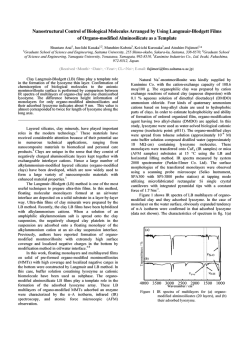
論文題名 :Preparation of Acrylic Monomer Grafted PET
(様式2) 氏 名 :Nazia Rahman(ナジア ラーマン) 論文題名 :Preparation of Acrylic Monomer Grafted PET Films by γ ray Irradiation for Selective Adsorption of Hazardous Metal Ions (アクリル酸モノマーのガンマ線照射グラフトによる 有害金属イオン選択吸着 PET フィルムの開発) 区 :甲 分 論 文 内 容 の 要 旨 Ignited by the notorious environmental destruction cases: Minamata disease (organic mercury poisoning) and Itai-itai disease (cadmium poisoning), heavy metals have received much public attentions as potential hazards for human health and life in recent years. In this situation, stricter heavy-metal-discharge regulations accelerate the development of efficient and low-cost heavy-metal-waste removal technologies. However, conventional methods such as precipitation, ion exchange, activated carbon adsorption and electrodeposition methods have disadvantages on cost, removal ability and easiness of cyclical use. Therefore, many researches have been seeking for alternative low-cost and effective adsorbents. Under these circumstances, the author has paid attention to polyethylene terephthalate (PET) as a base material for these adsorbents. PET is widely used for making containers because of its chemically, thermally and mechanically stable properties. Nowadays, PET bottles have become one of the most commonly consumed and disposed plastic products in daily life, which also causes a vital global-issue on their recycle. Japan’s success in PET recovery is recognized worldwide: in 2010, collection rate of PET bottles was 72% in Japan, while 48% in Europe and 29% in the United States. However, it is also well known that about 53% of the collected PET bottles in Japan are exported to other countries: the vast majority to China. Such the outflow abroad slows the recovered-PET recycling in Japan; in addition, the export of any material causing environmental pollution or increasing environmental burden to importing countries is against the spirit of Basel Convention. In these circumstances, the author has convinced that the utilization of the waste-PET for removing hazardous materials can be an effective way from viewpoints of both the PET-recycle and the development of the low-cost environment purification materials, and therefore, the author has studied heavy-metal-adsorption functionalities of the adsorbents made of PET materials. This thesis is the compilation of author’s investigation results on the development of the new PET adsorbents, and is composed of 5 chapters. Chapter 1 shows the background and objectives of the present study including brief explanations on grafting of functional monomers on PET with an emphasis on the advantage of γ-ray induced grafting. Chapter 2 describes the most important findings of the present study, a pre-treatment effect to γ-ray induced grafting of acrylamide (AAm) onto PET films. The PET films treated with hot (100 to 160 °C) dimethyl sulfoxide (DMSO) prior to γ-ray grafting were found to show considerably high AAm graft yields (the highest yield, 15.5 % / 1125 μg/cm2), which are much higher than those achieved using conventional γ-ray induced grafting (~ 0 %) and other non-chemical grafting techniques [such as UV irradiation (~ 0.3 %), CO2 laser irradiation (~ 359 μg/cm2) and the SI-ATRP (surface-initiated atom transfer radical polymerization) (~ 2.52 %) methods]. The author also found that PET films exhibit noticeable surface-morphological changes during the hot DMSO pre-treatment procedure including micro-pore creation, which was estimated to promote the AAm grafting found in the present study. In Chap. 3, the author examined Hg(II)-selective-adsorption ability of the AAm-grafted PET films prepared by the newly developed hot DMSO pre-treatment procedure (Chap. 2). In the measurements of captured Hg(II) and Pb(II) amounts from their mixture solution (with the same initial concentration of 100 mg/L at pH 4.5), the newly developed films were found to show much higher adsorption-selectivity for Hg(II) (~ 24 mg/g) over Pb(II) (~ 5 mg/g) than other adsorbents, which was estimated to result from the AAm-amide-group’s high ability forming covalent bonds with Hg(II). The author also found that the selective Hg(II) adsorption equilibrium data follow the Langmuir model and the adsorption kinetic data are well-fitted by a pseudosecond-order equation, which indicate almost the monolayer arrangement of Hg(II) on the adsorbent surface and diamido-mercury-species formation through the reaction between one Hg(II) ion and two amide-groups, respectively. The author also confirmed that the adsorbed Hg(II) and Pb(II) are effectively desorbed by a simple acid-treatment and that the regenerated film showed almost no marked adsorption-capacity loss. The selective recovery of Hg(II) from the mixture solution with other heavy metals having closely similar properties to Hg(II), such as Pb(II), is very important for their recycle because they are usually toxic but valuable. In Chap. 4, the author further examined Cu(II)-selective-adsorption efficiency of the acrylic acid (AAc) grafted PET films prepared by the newly developed hot DMSO pre-treatment procedure (Chap. 2). In the measurements of the captured amounts of Cu(II), Co(II) and Ni(II) from their aqueous mixture (with the same initial concentrations of 2000 mg/L at pH 4), the newly developed AAc-grafted films were found to show higher selectivity towards Cu(II) (~55 mg/g) over other heavy metals (7.8 mg/g for Co(II) and ~ 9.0 mg/g for Ni(II)) than other adsorbents, which was attributed to the carboxylate group’s ability to form more stable complex with Cu(II) than Co(II) or Ni(II). It was also confirmed that the isothermal adsorption and adsorption kinetics of the AAc-grafted PET films can be also explained by the Langmuir model and pseudo-second-order equation, respectively. The author also demonstrated the easiness of the heavy-metal desorption and of the adsorbent reuse indicating that the newly developed films are considered to suit the repeated use in the Cu(II)selective recycle from the waste solution containing Cu(II), Co(II) and Ni(II), which show closely similar properties and are individually valuable. Chapter 5 describes summary of the present study and brief discussions on future work. 〔作成要領〕 1.用紙はA4判上質紙を使用すること。 2.原則として,文字サイズ10.5ポイントとする。 3.左右2センチ,上下2.5センチ程度をあけ,ページ数は記入しないこと。 4.要旨は2,000字程度にまとめること。 (英文の場合は,2ページ以内にまとめること。) 5.図表・図式等は随意に使用のこと。 6.ワープロ浄書すること(手書きする場合は楷書体)。 この様式で提出された書類は,「九州大学博士学位論文内容の要旨及び審査結果の要旨」 の原稿として写真印刷するので,鮮明な原稿をクリップ止めで提出すること。
© Copyright 2025
